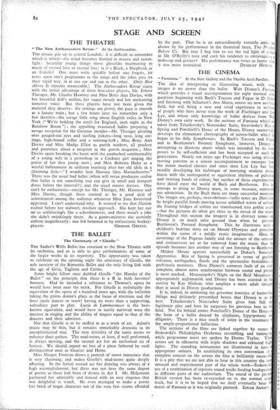THE BALLET
The Centenary of " Giselle " THE Sadlees Wells Ballet has returned to the New Theatre with its orchestra, and so is able to give performances of some of the larger works in its repertory. The opportunity was taken to celebrate on the opening night the centenary of Giselle, the sole survivor of the Romantic Ballet and the only living link with the age of Grisi, Taglioni and Cerito.
Some bright fellow once dubbed Giselle "the Hamlet of the Ballet" on the principle that there is a B in both heroines' bonnets. Had he intended a reference to Thomas's opera he would have been near the mark. For Giselle is stylistically the equivalent of the opera of a hundred years ago, with the ballerina taking the prima donna's place as the focus of attention and the hero (male dancer or tenor) having no more than a supporting, subsidiary part to play. Lucia di Lammermoor is the best- known equivalent, and would have as surely survived were the interest in singing and the ability of singers equal to that of the dancers and their admirers.
Not that Giselle is to be sniffed at as a work of art. Adam's music may be thin, but it remains remarkably dramatic in its unsophisticated way. The very triviality of the tunes seems to enhance their pathos. The mad-scene, at least, if well performed, is always moving, and the second act has an enchanted air of fantasy. We should expect no less of a piece fathered by such distinguished men as Gautier and Heine.
Miss Margot Fonteyn draws a portrait of sweet innocence that is very charming, and makes Giselle's mad-scene quite deeply affecting. In the lyrical second act her dancing was always of a high accomplishment, but there was not here the same degree of poetry as there had been of drama in Act I. Mr. Helpmann partnered her admirably and danced with an easy elegance that was delightful to watch. He even managed to make a pretty fair brick of tragic character out of the very few straws afforded
by the part. That he is an extraordinarily versatile artist was shown by his performance in the theatrical farce, The PrOspea Before Us. But may I beg him to see the red light of danger in Mr. O'Reilly's nose and curb his tendency to extravagance et make-up and gesture? His performance was twice as funny when


























 Previous page
Previous page